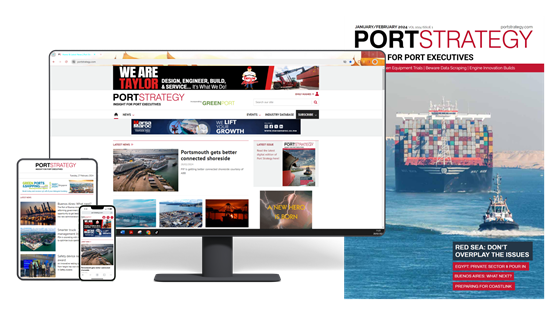Terminal Operations – Page 60
-
News
A huge and ambitious global undertaking
Notwithstanding a rather gloomy picture, we must remember that it is still early days. The implementation of the ISPS Code has been a huge and ambitious global undertaking and we are all learning as we go along.
-
 News
NewsIs it working?
Following the 9/11 attacks, the IMO went into a frenzy of unprecedented activity. Chris Austen analyses the upshot of all this on the ports sector.
-
 News
NewsISPS A Year On
There is little doubt that for many in the ports and terminals industry the build-up to and implementation of the ISPS Code in July 2004 came as something of a shock to the system. TT Club believes the industry deserves a pat on the back.
-
 News
NewsNot in my Back Yard!
The relationship between ports that need to develop and their surrounding social and ecological environments is very often a matter for heated debate with the NIMBY factor usually to the fore.
-
News
Deal with EIA sooner rather than later
Here Royal Haskoning makes a rational appraisal of a sensitive subject.Recommendations resulting from the EIA process may affect development by requiring changes that influence the design, economic viability or timing of implementation in order for the development to gain approval. To be of most benefit it is necessary for EIA ...
-
 News
NewsSealing the Box
Within the plethora of directives, regulations, codes and initiatives, and the accompanying smart technology that the reaction to 9/11 has given birth to, the container seal has always been in the cross hairs. Nick Elliott reports.
-
News
What is Radio Frequency Identification?
RFID - Radio Frequency Identification - is an Automatic Data Collection (ADC) technology that uses radio-frequency waves to transfer data between a reader and a movable item to identify, categorize, and track. RFID is fast, reliable, and does not require physical sight or contact between reader/scanner and the tagged item. ...
-
News
How and Who to Charge
A recent study by Cameron Maritime Resources has identified how governments and operators have been financing and recovering costs associated with the ISPS Code. Steve Cameron takes a snapshot of approaches around the world.
-
 News
NewsAVEN ENERABLE TECHNOLOGY
On its own or integrated with other technologies, OCR can enhance efficiency and security in intermodal operations. Terry Gibson of SAIC explains.
-
News
ARMING THE BOX AGAINST INTRUDERS
With CSI in mind, General Electric (GE) has, despite the irony of completing commercial field testing of its new product on the same day in January that the 32 Chinese stowaways were caught clambering out of their 40ft containers, developed what is claimed to be an inexpensive solution to the ...
-
News
WHAT'S IN THAT BOX?
The 24-hour rule, CSI, TESC and a stowaway sensor are just some of the measures aimed at securing the supply chain. Patrik Wheater reports.
-
 News
NewsNAVAL TECHNOLOGY SHIELDS THE WATERFRONT
Sophisticated electronics, signal processing, unmanned underwater vehicle (UUV) and command and control technology developed for naval applications are all being used to makes ports and harbours safer, as David Foxwell writes.
-
 News
NewsNEW STANDARD ON ITS WAY
A new design code for the design of ro-ro ramps, linkspans and walkways - British Standard 6349 Part 8 - is due to be published early next year, enabling ro-ro infrastructure to be planned, designed and built to an acceptable common set of rules, as explains.
-
 News
NewsROSAFE UPS THE STANDARD
As highlighted above, although accidents have been relatively rare, passenger safety is of interest to everyone in the industry, and, with this in mind, a new safety device for ferry linkspans has been produced jointly by Royal Haskoning and Bosch Rexroth.
-
 News
NewsENSURING SECURITY WHILST INCREASING EFFICIENCY
Despite a lack of agreed standards, there''s a wide range of technologies available to increase security while enhancing efficiencies in container terminals, writes Benedict Young.
-
 News
NewsMORTAR IN THE WATER
Another way to reinforce steel piling that has been subjected to ALWC is to use a reinforcing concrete. UK-based Flexcrete uses a wide range of purpose-designed marine mortars, sprayed mortars and unique cementitious coatings based on its advanced microsilica, polymer and fibre technology, to protect marine structures.
-
 News
NewsSEEKING SOLUTIONS TO ALWC
Despite extensive research now being undertaken, for the time being there is little comprehensive, independent, user-friendly guidance available about Accelerated Low Water Corrosion (ALWC), perhaps the most serious problem affecting steel piling in ports and harbours today. David Foxwell investigates.
-
News
SEALING THE SUBSTRATE
Although generally speaking more resistant to corrosion and other forms of degradation than steel piles or many other marine structures, over the course of time concrete may itself need additional protection.
-
 News
NewsFROM BERTH TO BREAKWATER SOME VERY CONCRETE REASONS
Concrete''s value within the port environment is almost unlimited. And fresh innovations incorporating its use are appearing all the time, as David Foxwell discovers.
-
 News
NewsDECKING AND REINFORCEMENT FOR FERRY SERVICE
A new deep water jetty for ro-ro ferries serving the Orkney Isles has recently entered service that makes extensive use of concrete, both in the decking for the jetty and as a means of reinforcing the piles on which it sits.






